Delonghi DEFL605E Product Manual

DE’LONGHI
COOKING
INSTALLATION and SERVICE INSTRUCTIONS
USE and CARE INSTRUCTIONS
DEFL605E
CERAMIC COOKER
distributed by
DeLonghi Australia Pty Ltd
DeLonghi New Zealand Ltd

Dear Customer,
Thank you for having purchased and given your preference to our product.
The safety precautions and recommendations reported below are for your own safety and that of others. They will also provide a means by which to make full use of the features offered by your appliance.
Please keep this booklet in a safe place. It may be useful in future, either to yourself or to others in the event that doubts should arise relating to its operation.
This appliance must be used only for the task it has explicitly been designed for, that is for cooking foodstuffs. Any other form of usage is to be considered as inappropriate and therefore dangerous.
The manufacturer declines all responsibility in the event of damage caused by improper, incorrect or illogical use of the appliance or be faulty installation.
This appliance has been designed and constructed in accordance with the following codes and specifications:
AS/NZS 60335.1
AS/NSZ 60335.2.6
AS/NZS CISPR 14.1
Household and similar electrical appliances - Safety General requirements
Safety Particular requirements for stationary cooking ranges, hobs, ovens and similar appliances
Electromagnetic Compatibility Requirements
PRODUCT LABEL
2

IMPORTANT SAFETY PRECAUTIONS AND RECOMMENDATIONS
IMPORTANT: This appliance is designed and manufactured solely for the cooking of domestic (household) food and is not suitable for any non domestic application and therefore should not be used in a commercial environment.
The appliance guarantee will be void if the appliance is used within a non domestic environment i.e. a semi commercial, commercial or communal environment.
Read the instructions carefully before installing and using the appliance.
■■ This appliance has been designed and manufactured in compliance with the applicable standards for the household cooking products, including those for surface temperatures.
Some people with sensitive skin may have a more pronounced temperature perception with some components although these parts are within the limits allowed by the norms.
The complete safety of the appliance also depends on the correct use, we therefore recommend to always pay a extreme attention while using the product, especially in the presence of children.
■■ After having unpacked the appliance, check to ensure that it is not damaged and that the oven door closes correctly.
In case of doubt, do not use it and consult your supplier or a professionally qualified technician.
■■ Packing elements (i.e. plastic bags, polystyrene foam, nails, packing straps, etc.) should not be left around within easy reach of children, as these may cause serious injuries.
■■ Some appliances are supplied with a protective film on steel and aluminium parts. This film must be removed before using the appliance.
■■ IMPORTANT: The use of suitable protective clothing/gloves is recommended when handling or cleaning this appliance.
■■ Do not attempt to modify the technical characteristics of the appliance as this may become dangerous to use. The manufacturer declines all responsibility for any inconvenience resulting from the inobservance of this condition.
3
■■ Do not operate your appliance by means of an external timer or separate remote-control system.
■■ Do not carry out cleaning or maintenance operations on the appliance without having previously disconnected it from the electric power supply.
■■ WARNING: Ensure that the appliance is switched off before replacing the oven lamp to avoid the possibility of electric shock.
■■ Do not use a steam cleaner because the moisture can get into the appliance therefore making it unsafe.
■■ Do not touch the appliance with wet or damp hands (or feet). ■■ Do not use the appliance whilst in bare feet.
■■ If you should decide not to use this appliance any longer (or decide to substitute another model), before disposing of it, it is recommended that it be made inoperative in an appropriate manner in accordance to health and environmental protection regulations, ensuring in particular that all potentially hazardous parts be made harmless, especially in relation to children who could play with unused appliances.
■■ The various components of the appliance are recyclable. Dispose of them in accordance with the regulations in force in your country.
If the appliance is to be scrapped, remove the power cord. ■■ After use, ensure that the knobs are in the off position.
■■ Children less than 8 years of age shall be kept away unless continuously supervised.
■■ This appliance can be used by children aged from 8 years and above and persons with reduced physical, sensory or mental capabilities or lack of experience and knowledge if they have been given supervision or instruction concerning use of the appliance in a safe way and understand the hazards involved. Children shall not play with the appliance. Cleaning and user maintenance shall not be made by children without supervision.
■■ The manufacturer declines all liability for injury to persons or damage to property caused by incorrect or improper use of the appliance.
4
■■ WARNING: During use the appliance and its accessible parts become hot; they remain hot for some time after use.
––Care should be taken to avoid touching heating elements (on the hob and inside the oven).
––The door is hot, use the handle.
––To avoid burns and scalds, young children should be kept away.
■■ Make sure that electrical cables connecting other appliances in the proximity of the cooker cannot come into contact with the hob or become entrapped in the oven door.
■■ WARNING: Unattended cooking on a hob with fat or oil can be dangerous and may result in fire. NEVER try to extinguish a fire with water, but switch off the appliance and then cover flame e.g. with a lid or a fire blanket.
■■ WARNING: Danger of fire: do not store items on the cooking surfaces.
■■ Do not place or leave empty pans on the glass ceramic hob.
■■ Do not allow heavy or sharp objects to drop on the glass ceramic hob.
■■ Do not scratch the hob with sharp objects. Don’t use the hob as a work surface.
■■ WARNING: If the hob is cracked or otherwise damaged by falling objects etc., disconnect the appliance from the electrical power supply to avoid the possibility of electric shock and call Customer
Service.
■■ WARNING: When correctly installed, your product meets all safety requirements laid down for this type of product category.
However special care should be taken around the rear or the underneath of the appliance as these areas are not designed or intended to be touched and may contain sharp or rough edges, that may cause injury.
■■ FIRST USE OF THE OVEN - it is advised to follow these instructions:
––Furnish the interior of the oven as described in the chapter
“CLEANING AND MAINTENANCE”.
5
––Switch on the empty oven on max to eliminate grease from the heating elements.
––Disconnect the appliance from the electrical power supply, let the oven cool down and clean the interior of the oven with a cloth soaked in water and neutral detergent; then dry carefully.
■■ CAUTION: Do not use harsh abrasive cleaners or sharp metal scrapers to clean the oven door glass since they can scratch the surface, which may result in shattering of the glass.
■■ Do not line the oven walls or base with aluminium foil. Do not place baking trays or the drip tray on the base of the oven chamber.
■■ FIRE RISK! Do not store flammable material in the oven or in the storage compartment.
■■ Always use oven gloves when removing the shelves and food trays from the oven whilst hot.
■■ Do not hang towels, dishcloths or other items on the appliance or its handle – as this could be a fire hazard.
■■ Clean the oven regularly and do not allow fat or oils to build up in the oven base or tray. Remove spillages as soon as they occur.
■■ Do not stand on the cooker or on the open oven door.
■■ Always stand back from the appliance when opening the oven door to allow steam and hot air to escape before removing the food.
■■ SAFEFOODHANDLING:Leavefoodintheovenforasshortatime as possible before and after cooking. This is to avoid contamination by organisms which may cause food poisoning. Take particular care during warmer weather.
■■ WARNING: Take care NOT to lift the cooker by the door handle.
■■ CAUTION:The cooking process has to be supervised.Ashort term cooking process has to be supervised continuously.
■■ The appliance must not be installed behind a decorative door in order to avoid overheating.
■■ The oven accessories (e.g. oven wire rack) must be fitted correctly as indicated at page 17.
■■ If the power supply cable is damaged, it must be replaced only by an authorized service agent in order to avoid a hazard.
6

INSTALLATION
CAUTION:
■■ This appliance must be installed in accordance with these installation instructions. ■■ This appliance shall only be serviced by authorised personnel.
■■ This appliance is to be installed only by an authorised person in compliance with the current electrical regulations and in observation of the instructions supplied by the manufacturer.
Failure to comply with this condition will render the guarantee invalid.
■■ Incorrect installation, for which the manufacturer accepts no responsibility, may cause personal injury of damage.
■■ Always disconnect the appliance from mains power supply before carrying out any maintenance operations or repairs.
LOCATION
■■ The cooker can be installed in a cabinet (fig. 1).
■■ The cooker must be installed no less than 50 mm away from any side wall which exceed the height of the cooktop.
■■ The appliance must be housed in heat resistant units.
■■ The walls of the units must be capable of resisting temperatures of 75 °C above room temperature.
■■ Do not install the appliance near inflammable materials (eg. curtains).
■■ If you stand the cooker on a pedestal, make sure you provide safety measures to keep it in place.
7
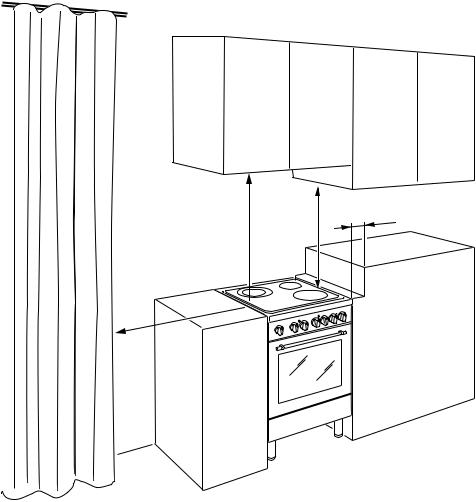
650 mm |
450 mm |
500 mm 

50 mm
Figure 1
Cooker overall dimensions [mm]
■■ height: min 850 - max 900 ■■ width: 600
■■ depth: 600
8
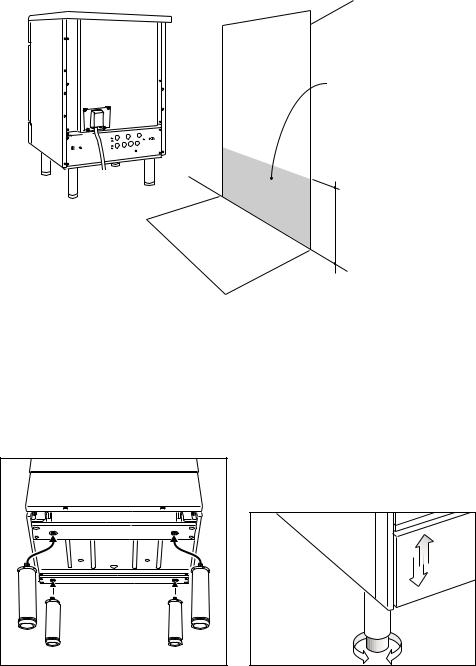
ELECTRIC CONNECTION |
|
Dotted line |
|
|
|
Figure 2 |
showing the |
|
|
position of the |
|
|
|
|
|
|
|
|
cooker when |
|
|
|
installed |
|
|
|
|
Area for ELECTRIC connection
min 270 mm max 320 mm (depending on feet height adjustment)
FITTING THE ADJUSTABLE FEET
The adjustable feet must be fitted to the base of the cooker before use (figs. 3, 4).
Rest the rear of the cooker on a piece of the polystyrene packaging exposing the base for the fitting of the feet.
Fit the no. 4 (four) legs by screwing them tight into the support base as shown in figure 3.
LEVELLING THE COOKER
The cooker may be levelled by screwing the lower ends of the feet IN or OUT (fig. 4).
Figure 3
Figure 4
9 |

MOVING THE COOKER
WARNING: When raising cooker to upright position always ensure two people carry out this manoeuvre to prevent damage to the adjustable feet (fig. 5a).
WARNING - Be carefull: Do not lift the cooker by the door handle when raising to the upright position (fig. 5b).
WARNING: When moving cooker to its final position DO NOT DRAG (fig. 5c). Lift feet clear of floor (fig. 5a).
Figure 5a
Figure 5b
Figure 5c
10
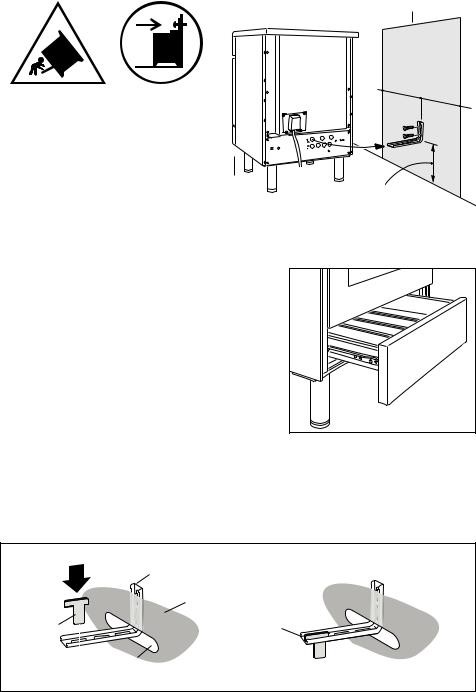
ANTI-TILT BRACKET
Important!
To restrain the appliance and prevent it tipping accidentally, fit a bracket to its rear to fix it securely to the wall. Make sure you also fit the supplied lock pin to the anti-tilt bracket.
To fit the anti-tilt bracket:
Figure 6a
0 
+50
Dotted line showing the position of the cooker when installed
=
1.After you have located where the cooker is to be positioned, mark on the wall the place where the two
screws of the anti-tilt bracket have to be fitted. Please follow the indications given in fig. 6a.
2.Drill two 8 mm diameter holes in the wall and
insert the plastic plugs supplied.
Important!
Before drilling the holes, check that you will not damage any pipes or electrical wires.
3. Loosely attach the anti-tilt bracket with the two screws supplied.
4.Move the cooker to the wall and adjust the height
of the anti-tilt bracket so that it can engage in the slot on the cooker’s back, as shown in fig. 6a.
5. Tighten the screws attaching the anti-tilt bracket.
6.Push the cooker against the wall so that the
antitilt bracket is fully inserted in the slot on the cooker’s back.
7.Access the bracket and fit the lock pin: ■■Remove the drawer (fig. 6b).
■■ Fit the lock pin through the bracket, as shown (fig. 6c). ■■Refit the drawer.
Figure 6c
1 |
Anti-tilt bracket |
2 |
attached on the |
||
|
rear wall |
|
Cooker’s |
Lock pin |
back |
correctly |
Lock pin |
fitted |
|
|
Slot on the |
|
cooker’s back |
|
Fitting the lock pin through the bracket
11
ELECTRICAL REQUIREMENTS
■■ The appliance must be connected to the mains checking that the voltage corresponds to the value given in the rating plate and that the electrical cable sections can withstand the load specified on the plate.
■■ A suitable disconnection switch must be incorporated in the permanent wiring, mounted and positioned to comply with the local wiring rules and regulations. The switch must be of an approved type installed in the fixed wiring and provide a 3 mm air gap contact separation in all poles in accordance with the local wiring rules.
In Australia and New Zealand, a switch of the approved type with a 3 mm air gap must be installed in the active (phase) conductor of the fixed wiring.
■■ The switch must always be accessible.
■■ The power supply cable must not touch the hot parts and must be positioned so that it does not exceed 75°C above ambient.
■■ To connect the cooker to the mains electricity supply, do not use adapters, reducers or branching devices as they can cause overheating and burning.
■■ This cooker must be connected to a suitable double pole control unit adjacent to the cooker. No diversity can be applied to this control unit.
■■ This cooker must be connected to electrical supply using V105 insulated cable.
In New Zealand, this appliance must be connected to the electrical supply using a cable fitted with an appropriately rated plug. The plug must be compatible with the socket-outlet fitted to the final subcircuit in the fixed wiring that is intended to supply the appliance.
■■ Once the appliance has been installed, the switch or socket must always be accessible.
■■ If the supply cord is damaged it must be replaced by the manufacturer or it’s Service
Agent or a similarly qualified person in order to avoid a hazard.
N.B. The connection of the appliance to earth is mandatory.
If the installation requires alterations to the domestic electrical system call a qualified electrician. He should also check that the domestic electrical system is suitable for the power drawn by the appliance.
Replacing the power cord must be done by a qualified electrician in accordance with the instructions supplied by the manufacturer and in compliance with established electrical regulations.
12
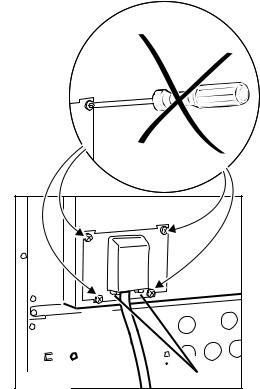
CONNECTION OF THE POWER SUPPLY CABLE
Important! This cooker must be connected to the electricity supply only by an authorised person.
■■ Unhook the terminal board cover by inserting a screwdriver into the two hooks “A” (fig.
7).
■■ Unscrew the screw “D” and open completely the cable clamp “E” (figs. 8 - 9 - 10).
■■ Position the U bolts “F” onto terminal board “G” (figs. 8 - 9- 10) according to the diagrams in fig. 11.
■■ Connect the phase, neutral and earth wires to terminal board “G” according to the diagrams in fig. 11.
■■ Strain the feeder cable and block it with cable clamp “E” (by screwing screw “D”). ■■ Close the terminal block cover (check the two hooks “A” are correctly hooked).
NOTE: The earth conductor must be left about 3 cm longer than the others.
VOLTAGE AND POWER CONSUMPTION
220-240 V 50 Hz 8470 W (36.8 A) (diversity not applied)
Figure 7 |
A |
|
FEEDER CABLE SECTION “TYPE H05RR-F or H05VV-F”
220-240 V ac |
3 x 4 mm2 |
(**) |
380-415 V 3N ac |
5 x 2,5 mm2 (**) |
|
380-415 V 2N ac |
4 x 4 mm2 |
(**) |
(**) Connection with wall box connection.
––Diversity factor applied.
––A diversity factor may be applied to the total loading of the appliance only by a suitably qualified person.
13
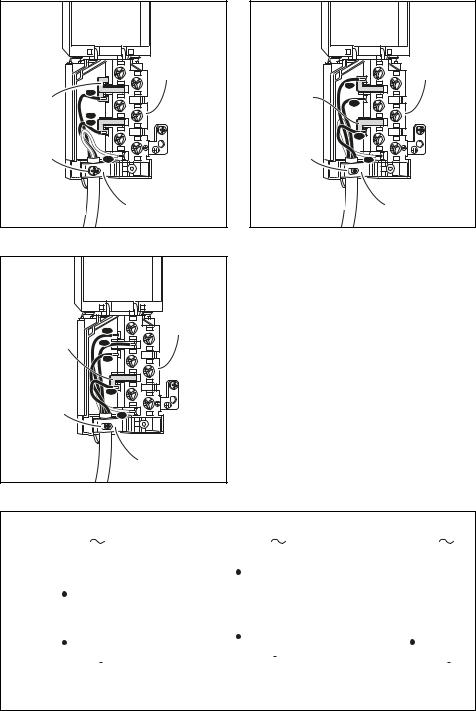
|
|
1 |
G |
|
|
1 |
G |
|
|
2 |
|
|
2 |
||
|
|
|
|
F |
L1 |
|
|
F |
L1 |
3 |
|
|
3 |
|
|
|
|
L2 |
|
||||
|
|
4 |
|
|
|
4 |
|
|
N |
|
|
|
|
|
|
|
L2 |
|
|
|
5 |
|
5 |
|
|
|
N |
D |
PE |
D |
PE |
220-240 V ac |
E |
|
400 |
~ |
E |
|
|
380-415 V 2N ac |
|
||||
230 V ~ |
|
Figure 8 |
|
|
|
Figure 9 |
|
|
|
|
|
||
|
|
1 |
G |
F |
L1 |
2 |
|
L2 |
|
|
|
|
L3 |
3 |
|
|
4 |
|
|
|
|
|
|
5 |
|
N |
D |
PE |
380-415 V |
3N |
ac |
|
|
|
400 V |
~ |
|
E |
Figure 10 |
|
|
|
|
|
||
|
|
|
|
|
|
220-240 V ac |
|
380-415 V 2N ac |
|
380-415 V 3N ac |
|||||||||||||||||||||||
|
|
230 V |
|
400 V 2N |
|
00 V 3N |
||||||||||||||||||||||
|
|
|
|
|
|
|
|
|
|
L1 |
|
|
|
|
|
|
|
|
|
|
|
|
|
|
|
|
||
|
|
|
|
|
|
|
|
|
1 |
|
|
|
L1 |
|
|
|
|
|
|
|
|
|||||||
|
|
|
|
1 |
|
|
|
|
|
|
|
|
|
|
|
|
|
1 |
|
|
|
|
||||||
|
L1 |
|
|
|
|
|
|
|
|
|
|
|
|
|
|
2 |
|
|
L2 |
|
|
|
|
|
|
|||
|
|
|
2 |
|
|
|
L2 |
|
|
|
|
|
|
|
2 |
|
|
|||||||||||
|
|
|
|
|
|
|
|
|
|
|
3 |
|
|
|
L3 |
|
|
|
|
|
|
|
|
|||||
|
|
|
|
3 |
|
|
|
|
|
|
|
|
|
|
|
3 |
|
|
|
|
||||||||
|
|
|
|
|
|
|
|
|
|
|
|
|
|
|
4 |
|
|
|
|
|
|
|
||||||
|
|
|
|
|
4 |
|
|
|
|
|
|
|
|
|
|
|
|
|
|
|
|
|
4 |
|
|
|||
N (L2) |
|
|
|
|
|
|
|
|
N |
|
|
|
5 |
|
|
|
N |
|
|
|
|
|
|
|
||||
|
|
5 |
|
|
|
|
|
|
|
|
|
5 |
|
|
|
|
||||||||||||
|
|
|
|
|
|
|
|
|
|
|
|
|
|
|
|
|
||||||||||||
|
PE |
|
|
|
|
|
|
|
|
PE |
|
|
|
|
|
|
PE |
|
|
|
|
|
|
|
||||
|
|
|
|
|
|
|
|
|
|
|
|
|
|
|
|
|
|
|
|
|
||||||||
|
|
|
|
|
|
|
|
|
|
|
|
|
|
|
|
|
|
|
|
|
|
|
|
|
||||
Figure 11
14
